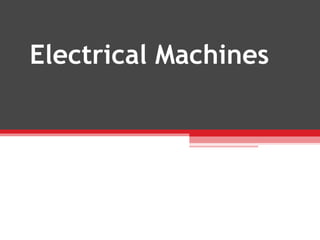
14+synchronous+motors
- 1. Electrical Machines LSEGG216A 9080V
- 2. Synchronous Motors Week 14
- 3. Introduction • State the principles of operation of a synchronous motor. • Identify the main parts of a synchronous alternator/motor. • List the methods used to provide the excitation of a synchronous alternator/motor. • List the starting methods of synchronous
- 4. Motor Types 3 Phase 1 Phase • Reluctance • Hysteresis • Permanent Magnet • Inductor
- 5. Characteristics • High operating efficiency • Smooth constant starting & accelerating torque • Versatile power factor control • Constant speed • Considerably more expensive than induction motors • Zero starting torque
- 6. Stator Same as an induction motor’s stator Some books may call this the Armature
- 7. Rotor • Wound simular to a wound rotor induction motor • When operating DC voltage is placed across this coil to produce an electromagnet Some books may call this the Field Windings
- 8. Motor Speed • Magnetic force is obtained from an external source (In an induction machine rotor’s magnetism is induced from the stator) • Rotor poles lock onto the RMF Called “Excitation” • Rotor operates at synchronous speed 120f N sync = = Nrotor P
- 10. Torque Angle Torque Angle Dependant on: • Load torque • Excitation • The magnetic link between the stator & the rotor can be thought of as a connecting spring. • The excitation can be used to strengthen the spring Full Load
- 11. Torque Angle If the load Torque fluctuates Or Changes rapidly • The magnetic “Spring” will bounce • Causing large fluctuations in supply current • Amortisseur windings are added to the rotor • Also known as hunting
- 12. Amortisseur Windings Similar to the squirrel cage found in induction machines Also Known as “Damper “ windings • When relative movement between the stator and the rotor poles occurs • Voltage is induced into these windings. • Subsequent induced magnetic field tends to slow movement and act like a “shock absorber” • Can be used to aid starting in a simular way to that of the squirrel cage conductors
- 13. Starting Zero starting Torque Number of methods: • Pony Motor • Low Frequency
- 14. Pony Motor Starting An auxiliary smaller motor is used to spin the main motor up to or near Synchronous speed
- 15. Starting Low Frequency • The rotor’s excitation windings are short circuited • Act like a wound rotor induction motor • Supply is applied at reduced voltage & frequency • Rotor builds up speed • Excitation is then applied to windings and rotor locks in Tumit 3 and the Shoalhaven hydro schemes use this system
- 16. Motor Uses • Can be used as a standard motor similar to an induction motor As an induction machine is cheaper it is seldom used just as a motor • Main use as a power factor correction device Sometimes called a rotary capacitor
- 17. Power Factor Correction And the Power Factor Improves The stator current will drop As we increase the excitation
- 18. Power Factor Correction And the Power Factor detieriates The stator current will increase If we continue to increase the excitation
- 19. Power Factor Correction Curve A = Stator Current Curve B = Power Factor These curves are known as “Vee Curves”
- 20. Power Factor Correction These curves are only applicable for a set load torque A different load will produce a different set of curves
- 21. Power Factor Correction If the bride is over excited she will Unity lead you to the marriage bed Lagging Leading Under Excited Over Excited
- 22. Power Factor Correction A motor has full load of 100A and an excitation current of 8A what will be: • The stator current? • PF of the motor?
- 23. Power Factor Correction PF = 0.9 Lagging Stator Current 38% X 100A = 38A
- 24. Example • A load of 450 kVA operates at a power factor of 0.65 lagging. • An additional synchronous motor is added having an input power of 90 kW and a maximum power factor of 0.85 leading. • Determine reactive power and the overall power factor 450 x cos 49.5°= 292.5kW 49.5° 450 x sin 49.5°= 450kVA 342kVar
- 25. Example • A load of 450 kVA operates at a power factor of 0.65 lagging. • An additional synchronous motor is added having an input power of 90 kW and a maximum power factor of 0.85 leading. • Determine reactive power and the overall power factor tan-1 x 286/382.5 = 36.8° 292.5 + 90 = 382.5kW PF = 0.8 Lag 90 x tan 31.8° = 292.5kW 31.8° 55.8kVar 342 – 55.8 = 286kVar 49.5° 90kW 450kVA 342kVar